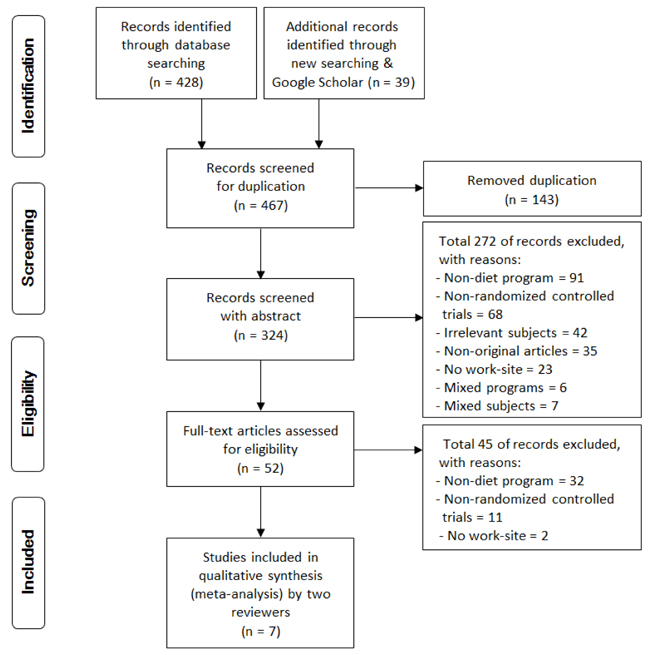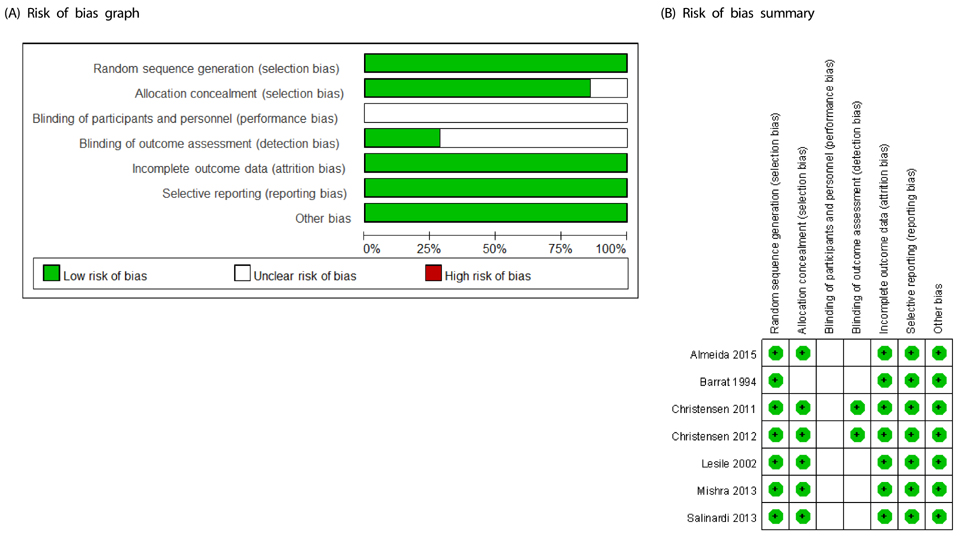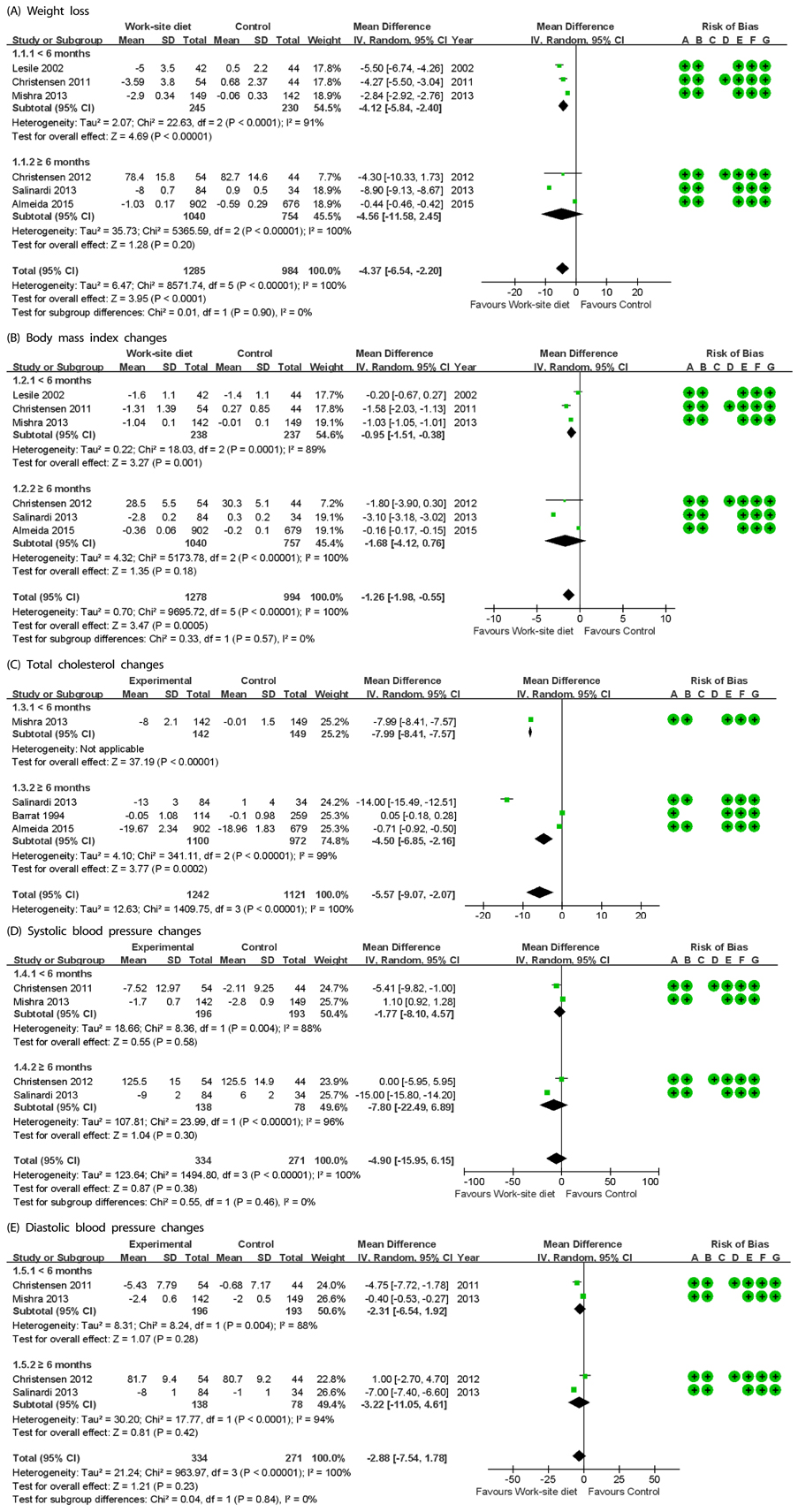Nutr Res Pract.
2019 Oct;13(5):399-409. 10.4162/nrp.2019.13.5.399.
Effectiveness of worksite-based dietary interventions on employees' obesity: a systematic review and meta-analysis
- Affiliations
-
- 1School of Nursing, Soonchunhyang University, Chungnam 31538, Korea.
- 2Department of Food Science and Nutrition, Soonchunhyang University, 22 Soonchunhyang-ro, Asan, Chungnam 31538, Korea. sonyah@sch.ac.kr
- KMID: 2464119
- DOI: http://doi.org/10.4162/nrp.2019.13.5.399
Abstract
- BACKGROUND/OBJECTIVES
This study was designed to provide scientific evidence on the effectiveness of worksite-based dietary intervention to reduce obesity among overweight/obese employees.
MATERIALS/METHODS
Electronic search was performed using Ovid Medline, Embase, Cochrane Library, and CINAHL databases. The keywords used were "obesity,""nutrition therapy," and "worksite." The internal validity of the randomized controlled trials (RCTs) was assessed using the Cochrane's Risk of Bias. Meta-analysis of selected studies was performed using Review Manager 5.3.
RESULTS
A total of seven RCTs with 2,854 participants were identified. The effectiveness of dietary interventions was analyzed in terms of changes in weight, body mass index (BMI), total cholesterol, and blood pressure. The results showed that weight decreased with weighted mean difference (WMD) of −4.37 (95% confidence interval (CI): −6.54 to −2.20), but the effectiveness was statistically significant only in short-term programs < 6 months (P = 0.001). BMI also decreased with WMD of −1.26 (95% CI: −1.98 to −0.55), but the effectiveness was statistically significant only in short-term programs < 6 months (P = 0.001). Total cholesterol decreased with WMD of −5.57 (95% CI: −9.07 to −2.07) mg/dL, demonstrating significant effectiveness (P = 0.002). Both systolic (WMD: −4.90 mmHg) and diastolic (WMD: −2.88 mmHg) blood pressure decreased, demonstrating effectiveness, but with no statistical significance.
CONCLUSIONS
The worksite-based dietary interventions for overweight/obese employees showed modest short-term effects. These interventions can be considered successful because weight loss was below approximately 5-10 kg of the initial body weight, which is the threshold for the management of obesity recommended by the Scottish Intercollegiate Guideline Network (SIGN).
Keyword
MeSH Terms
Figure
Reference
-
1. World Health Organization. Obesity and overweight fact sheet [Internet]. Geneva: World Health Organization;2016. cited 2017 July 15. Available from: http://www.who.int/mediacentre/factsheets/fs311/en/.2. Center for Disease Control and Prevention (US). Health, United States, 2016 with chartbook on long-term trends in health [Internet]. Atlanta (GA): Center for Disease Control and Prevention;2017. cited 2017 July 15. Available from: https://www.cdc.gov/nchs/data/hus/hus16.pdf.3. European Association for the Study of Obesity. Obesity facts and figures [Internet]. Paris: European Association for the Study of Obesity;2016. cited 2017 July 15. Available from: http://easo.org/education-portal/obesity-facts-figures/.4. Hruby A, Hu FB. The epidemiology of obesity: a big picture. Pharmacoeconomics. 2015; 33:673–689.
Article5. Wyatt SB, Winters KP, Dubbert PM. Overweight and obesity: prevalence, consequences, and causes of a growing public health problem. Am J Med Sci. 2006; 331:166–174.
Article6. Finkelstein E, Fiebelkorn C, Wang G. The costs of obesity among full-time employees. Am J Health Promot. 2005; 20:45–51.
Article7. Park S, Pan L, Lankford T. Relationship between employment characteristics and obesity among employed U.S. adults. Am J Health Promot. 2014; 28:389–396.
Article8. Katz DL, O'onnell M, Yeh MC, Nawaz H, Njike V, Anderson LM, Cory S, Dietz W. Task Force on Community Preventive Services. Public health strategies for preventing and controlling overweight and obesity in school and worksite settings: a report on recommendations of the Task Force on Community Preventive Services. MMWR Recomm Rep. 2005; 54:1–12.9. Harden A, Peersman G, Oliver S, Mauthner M, Oakley A. A systematic review of the effectiveness of health promotion interventions in the workplace. Occup Med (Lond). 1999; 49:540–548.
Article10. Elfhag K, Rössner S. Who succeeds in maintaining weight loss? A conceptual review of factors associated with weight loss maintenance and weight regain. Obes Rev. 2005; 6:67–85.
Article11. Scottish Intercollegiate Guidelines Network (UK). Management of obesity: a national clinical guideline [Internet]. Edinburgh: Scottish Intercollegiate Guidelines Network;2010. cited 2018 June 10. Available from: http://www.sign.ac.uk/sign-115-management-of-obesity.html.12. Geaney F, Kelly C, Greiner BA, Harrington JM, Perry IJ, Beirne P. The effectiveness of workplace dietary modification interventions: a systematic review. Prev Med. 2013; 57:438–447.
Article13. Maes L, Van Cauwenberghe E, Van Lippevelde W, Spittaels H, De Pauw E, Oppert JM, Van Lenthe FJ, Brug J, De Bourdeaudhuij I. Effectiveness of workplace interventions in Europe promoting healthy eating: a systematic review. Eur J Public Health. 2012; 22:677–683.
Article14. Ni Mhurchu C, Aston LM, Jebb SA. Effects of worksite health promotion interventions on employee diets: a systematic review. BMC Public Health. 2010; 10:62.
Article15. Higgins JP, Green S. Cochrane handbook for systematic reviews of interventions version 5.1.0 [Internet]. London: Cochrane Organization;2011. cited 2016 September 10. Available from: http://handbook-5-1.cochrane.org/.16. Moher D, Liberati A, Tetzlaff J, Altman DG. PRISMA Group. Preferred reporting items for systematic reviews and meta-analyses: the PRISMA statement. Ann Intern Med. 2009; 151:264–269.
Article17. Scottish Intercollegiate Guidelines Network (UK). Search filters [Internet]. Edinburgh: Scottish Intercollegiate Guidelines Network;2016. cited 2016 September 10. Available from: http://www.sign.ac.uk/search-filters.html.18. World Health Organization. Global database on body mass index [Internet]. Geneva: World Health Organization;2017. cited 2017 July 15. Available from: http://apps.who.int/bmi/index.jsp?introPage=intro_3.html.19. Almeida FA, You W, Harden SM, Blackman KC, Davy BM, Glasgow RE, Hill JL, Linnan LA, Wall SS, Yenerall J, Zoellner JM, Estabrooks PA. Effectiveness of a worksite-based weight loss randomized controlled trial: the worksite study. Obesity (Silver Spring). 2015; 23:737–745.
Article20. Mishra S, Xu J, Agarwal U, Gonzales J, Levin S, Barnard ND. A multicenter randomized controlled trial of a plant-based nutrition program to reduce body weight and cardiovascular risk in the corporate setting: the GEICO study. Eur J Clin Nutr. 2013; 67:718–724.
Article21. Salinardi TC, Batra P, Roberts SB, Urban LE, Robinson LM, Pittas AG, Lichtenstein AH, Deckersbach T, Saltzman E, Das SK. Lifestyle intervention reduces body weight and improves cardiometabolic risk factors in worksites. Am J Clin Nutr. 2013; 97:667–676.
Article22. Christensen JR, Overgaard K, Carneiro IG, Holtermann A, Søgaard K. Weight loss among female health care workers--a 1-year workplace based randomized controlled trial in the FINALE-health study. BMC Public Health. 2012; 12:625.
Article23. Christensen JR, Faber A, Ekner D, Overgaard K, Holtermann A, Søgaard K. Diet, physical exercise and cognitive behavioral training as a combined workplace based intervention to reduce body weight and increase physical capacity in health care workers - a randomized controlled trial. BMC Public Health. 2011; 11:671.
Article24. Leslie WS, Lean ME, Baillie HM, Hankey CR. Weight management: a comparison of existing dietary approaches in a work-site setting. Int J Obes Relat Metab Disord. 2002; 26:1469–1475.
Article25. Barratt A, Reznik R, Irwig L, Cuff A, Simpson JM, Oldenburg B, Horvath J, Sullivan D. Steering Committee. Work-site cholesterol screening and dietary intervention: the Staff Healthy Heart Project. Am J Public Health. 1994; 84:779–782.
Article26. World Health Organization. Global strategy on diet, physical activity and health [Internet]. Geneva: World Health Organization;2004. cited 2017 July 15. Available from: http://www.who.int/dietphysicalactivity/strategy/eb11344/strategy_english_web.pdf.27. Rosenbaum M, Leibel RL, Hirsch J. Obesity. N Engl J Med. 1997; 337:396–407.
Article28. Wadden TA, Foster GD. Behavioral assessment and treatment of markedly obese patients. In : Wadden TA, VanItallie TB, editors. Treatment of the Seriously Obese Patient. New York (NY): Guildford Press;1992. p. 290–330.29. National Institutes of Health (US). Methods for voluntary weight loss and control: National Institutes of Health Consensus Development Conference Statement [Internet]. Bethesda (MD): National Institutes of Health;1992. cited 2017 July 15. Available from: https://consensus.nih.gov/1992/1992WeightLossta010html.htm?tag=movievideos-20.30. Jeffery RW, Drewnowski A, Epstein LH, Stunkard AJ, Wilson GT, Wing RR, Hill DR. Long-term maintenance of weight loss: current status. Health Psychol. 2000; 19:5–16.
Article31. Kassirer JP, Angell M. Losing weight--an ill-fated New Year's resolution. N Engl J Med. 1998; 338:52–54.32. Wing RR, Phelan S. Long-term weight loss maintenance. Am J Clin Nutr. 2005; 82:222S–225S.
Article33. Lally P, Chipperfield A, Wardle J. Healthy habits: efficacy of simple advice on weight control based on a habit-formation model. Int J Obes (Lond). 2008; 32:700–707.
Article34. World Health Organization. Controlling the global obesity epidemic [Internet]. Geneva: World Health Organization;2017. cited 2017 July 15. Available from: http://www.who.int/nutrition/topics/obesity/en/.
- Full Text Links
- Actions
-
Cited
- CITED
-
- Close
- Share
- Similar articles
-
- An Analysis of Research on the Impact of School-Based Physical Education for Preventing Students' Obesity: Systematic Review and Meta Analysis
- Effectiveness of non-pharmacological interventions to reduce internalized stigma in people with severe mental illness: a systematic review and meta-analysis
- Website and Mobile Application-Based Interventions for Adolescents and Young Adults with Depression: A Systematic Review and Meta-Analysis
- An Introduction of the Systematic Review and Meta-Analysis
- Effects of medication adherence interventions for older adults with chronic illnesses: a systematic review and meta-analysis





